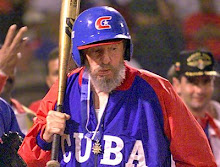Long Day's Descent Into Night
former Cuban political prisoner Jorge Valls, in his book Twenty Years and Forty Days:
Night was no time for rest. On the contrary, that was when the horrors began. At nine or so the executions would start.... Although we couldn't see the shootings from my galley, we could hear even the slightest sound. The still of the night and the echo of the pit made them even more pronounced.
Ramon Vidal Fuentes, interviewed by the Palm Beach Post:
I must have heard more than 700 or 800 executions during those years. Prison in the 1960s was a very, very difficult thing. Beatings. Killings. Torture. The things I've seen... It still hurts.
Jorge Valls and Vidal Fuentes are but two of many:
Among the executed there have been children, pregnant women, nuns, priests. It is a tremendously diverse population: blacks and whites, old and young, gay and straight, white collar and blue collar, liberals and conservatives.
Their stories take on a new dimension as the world awaits news of an ailing Castro and the transition of power in Cuba.
These witnesses tell stories of being kept in shuttered cells and drawerlike quarters, of being forced into labor camps for being homosexual, of watching their loved ones die at sea when Cuban gunboats attacked them.
In any other place and time, they might have had little in common. In revolutionary Cuba, they are united by one overriding condition: They beg to differ with Castro.
Night was no time for rest. On the contrary, that was when the horrors began. At nine or so the executions would start.... Although we couldn't see the shootings from my galley, we could hear even the slightest sound. The still of the night and the echo of the pit made them even more pronounced.
Ramon Vidal Fuentes, interviewed by the Palm Beach Post:
I must have heard more than 700 or 800 executions during those years. Prison in the 1960s was a very, very difficult thing. Beatings. Killings. Torture. The things I've seen... It still hurts.
Jorge Valls and Vidal Fuentes are but two of many:
Among the executed there have been children, pregnant women, nuns, priests. It is a tremendously diverse population: blacks and whites, old and young, gay and straight, white collar and blue collar, liberals and conservatives.
Their stories take on a new dimension as the world awaits news of an ailing Castro and the transition of power in Cuba.
These witnesses tell stories of being kept in shuttered cells and drawerlike quarters, of being forced into labor camps for being homosexual, of watching their loved ones die at sea when Cuban gunboats attacked them.
In any other place and time, they might have had little in common. In revolutionary Cuba, they are united by one overriding condition: They beg to differ with Castro.


0 Comments:
Post a Comment
<< Home